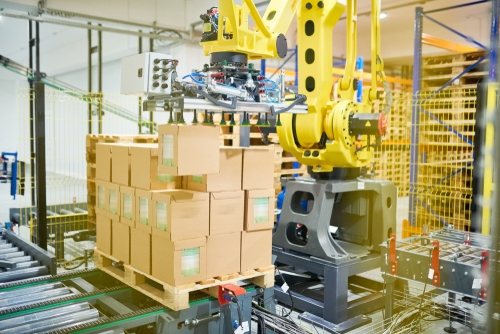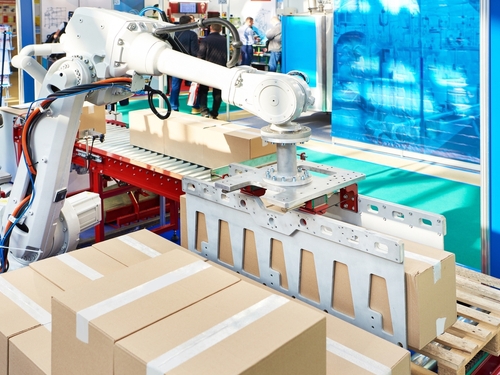Robotic Palletising Solutions for Advanced Automation
In the realm of robotic palletising, the intricate tasks of layer formation and pallet assembly are seamlessly managed by robotic components. These components come in various forms tailored to specific applications, from gantry robots operating along two to four axes to articulated robotic arms with up to six axes, equipped with a wide range of end-of-arm tools (EOAT) to handle diverse products.
Robotic palletising systems can be supplied by single or multiple inline conveyors and can construct one or multiple pallets simultaneously. This technology often results in significant space optimisation compared to traditional methods, enhancing warehouse efficiency.
Following a palletising pattern, the robot can retrieve multiple units from a conveyor to build layers on a pallet. Fully automated models improve productivity with slip sheet dispensers, pallet dispensers, and exit pallet conveyors for increased speed and usability.
Advantages of Opting for a Robotic Palletizer
Capable of handling up to 40 bags per minute, a robotic palletiser can efficiently manage diverse products, including cases, drums, and pails, reaching speeds of up to 1,200 cans per minute.
With fewer moving parts, robotic palletisers offer reduced downtime and exceptional reliability, featuring Mean Time Between Failure (MTBF) rates up to 80,000 hours and short Mean Time To Repair (MTTR) rates.
Although comparable in size to conventional models, robotic palletisers stand out for their modularity and flexibility, fitting seamlessly into confined spaces while meeting safety standards.
Cost-effective and scalable, the price depends on the level of automation, product type, and throughput. Handling requirements, such as empty pallet and slip sheet management, can influence the overall cost.
With multiple grippers, robotic palletisers offer unmatched versatility, handling various container types with ease. Vision systems also enable sorting of different SKUs, making robotic palletising an ideal solution for complex logistics.
In scenarios involving multiple infeeds of different Stock Keeping Units (SKUs), vision systems can relay information to the robot, enabling it to allocate SKUs onto different pallets. Moreover, for applications requiring bag overlapping on pallets or depalletizing various container types, the robotic palletizer proves to be an ideal solution.

Ready to revolutionise your palletising processes? Contact Z.O.N.D today to discuss a tailored robotic palletising solution.


